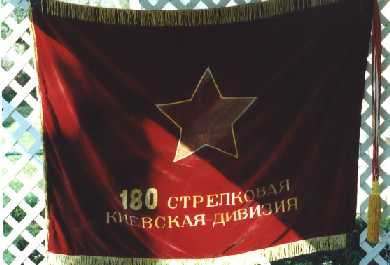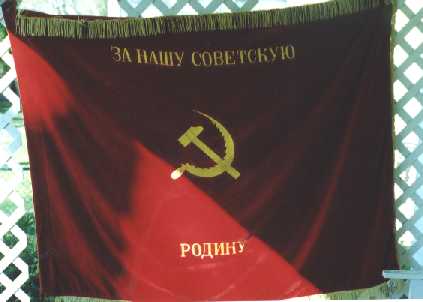
|
On June 18th 1942, in Tcherepovets (Arkhangelsk Military
District) in the Soviet far north from a yet as unidentified
rifle brigade. The brigade was most likely from reserve or
training forces in the area. The new 180th Rifle Division (new,
as the first 180th Rifle Division had been renamed the 28th
Guards Rifle Division) was formed with the following units:
-21st Rifle Regiment
- 42nd Rifle Regiment
-86th Rifle Regiment
-627th Artillery Regiment
-15th Antitank Battalion
-33rd Sapper / Engineering Battalion


The first division commander was Major General Fyodor Petrovich
Shmelev. In late June 1942 the division was assigned to the 10th
Reserve Army of Lt. General V.S. Popov, of the STAVKA reserve.
In August of 1942 the 180th Rifle Division was transferred to the
reserves of the 31st Army led by Major General V.S. Polenov, of
Marshal Zhukovs Western Front. By September of 1942 the division
was transferred back to the STAVKA reserve (2nd Reserve Army).
In January of 1943 the division finally saw a combat posting with
its assignment to the 3rd Tank Army ( Major General P.S. Rybalko)
of Army General Golikovs Voronezh front. The Division was now
under the command of Major General I. Ia. Maloshitsky. The
division was transferred to the 69th Army (Lt.General M.I.
Kazakov) and took part in the liberation of Borisovka. During
this battle General Maloshitsky was killed in combat when
division HQ was destroyed. General Maloshitsky had been awarded
the Order of Suvorov (2nd class) for the units participation in
the battle of Kharkov.
February 23rd, 1943, marked the beginning of the divisions
participation in the liberation of Kharkov. The division had
captured Kolmak Railroad station and the surrounding towns west
of Kharkov. The division failed to capture the Artemovka Railroad
station, and went over to the defense on March 7, 1943. The
German counterattack destroyed the division's HQ ( the probable
loss location of the original divisional standard). The German
counterattack also destroyed all of the divisions anti-tank
weapons, and forced it to withdraw to positions near Kachalovka.
On 12 March the division was ordered by the common of 69th Army
to withdraw to new defensive positions (line of Guberevka-
Pavlovka- Dimitrovka- Bogodukhov). German attacks near Bogodukhov
gutted the 21st Rifle Regiment and the 86th Rifle Regiment of the
division. The division continued to move to the rear until it
reached Kazach'ia Lopan on 12th of March, where it was
re-subordinated to the 40th Army. The 180th Rifle Division was
then tasked with taking up a defensive position outside of
Belgorod, to prevent its recapture. The division was gutted and
General Maloshitsky killed in heavy battle with the German
'Grossdeutchland' division.
Following this intense period of fighting the division was
withdrawn on March 20th to a position further north, on the south
flank of the newly formed Kursk salient. During the previous
weeks of fighting the 180th Rifle Division liberated 150 towns
and villages, destroyed the 385th and 387th Rifle regiments of
the Italian 85th Infantry Division, took 14,000 enemy prisoners,
killed 7,000 enemy soldiers, and captured or destroyed hundreds
of tons of supplies. The losses during this period were also high
with 1,661 men killed and 4,345 wounded. The division also lost
most of its equipment. The division, by late March 1943, was
totally gutted.
In late March 1943 the division was again reassigned to Lt.
General N.E. Chibisovs 38th army. It was placed under the 51st
Rifle Corps (Major General P.P. Avdeyenko). By September of 1943
the division was in battle at Sumy with the 51st Rifle Corps.
On November 6th 1943 the division took part in the liberation of
Kiev with Army General Vatutins 1st Ukrainian Front. During this
battle the 180th Rifle Division was awarded the honor title
'Kievskaya' and the Order of the Red Banner. On the night of
November 6th the divsion was one of a number of units honored
with a 24 round salute from 324 guns in Moscow.
In mid-November, 1943 the division was briefly transferred to
Lieutenant-General F.F. Zhmachenko's 40th Army of the 1st
Ukrainian Front. In December 1943 the division was transferred to
Colonel-General S.G. Trofimenko's 27th Army (1st Ukrainian
Front). From December 25th, 1943 to January 15th , 1944 fought
south-west of Kiev in the 47th Rifle Corps of the 27th Army. It
then assisted in the liberation of Yampol.
In February 1944 the 180th Rifle Division fought in the
Korsun-Shevchenkovskii Operation. It began the operation in the
27th Army (1st Ukrainian Front) subordinated directly to the
Army, not in the 47th Rifle Corps. Positioned on the 27th Army's
right (south) flank between the 27th Army's 337th Rifle Division
and the 167th Rifle Division of the 47th Rifle Corps of the 40th
Army. It broke through to Selyi Kut on January 27th. The division
subsequently formed part of the western edge of the ring
encircling the Korsun-Shevchenkovskii German pocket directly
facing the German "Blocking Detachment Fouquet". Later
fought against the SS "Narva" unit and was one of the
key defenders against the south edge of the German pocket where
they fought together with the 5th Guards Cavalry Corps.
On February 12th, 1944, 2400 hours, transferred, along with the
entire 27th Army, to Konev's 2nd Ukrainian Front during the
course of the Korsun-Shevchenkovskii Operation. Positioned with
the 18th Tank Corps just north of Lisyanka during the German's
February 14th to 16th breakout attempt. The division participated
in the capture of the town of Boguslav. On February 27th, 1944
the 180th fought against the Panzer Grenadier Regiment
"Germania" at Olshana. The 180th spent much of spring
1944 recovering with the 35th Guards Rifle Corps of the 27th
Army. Command was taken over by Major-General Anton
Aleksandrovich Pavlovich.
In May 1944 the division fought in the 27th Army at Targul
Frumos, and in July 1944 was transferred to the RVGK reserve. By
August 1944 the 180th fought in the Iassi-Kishinev operation as a
breakthrough division in Lieutenant-General I.T. Shmelin's 46th
Army in Malinovskii's 2nd Ukrainian Front. The 180th Rifle
Division was awarded the honorific title
"Transylvanskaya".
From December 1944 to February 13th, 1945 the division fought at
Budapest in Major-General Ivan Anreyevich Rubanyuk's 10th Guards
Rifle Corps in the 46th Army, now in Tolbukhin's 3rd Ukrainian
Front. Participated in the battle of Budapest, where it again
suffered heavy losses. In mid-February, 1945 General Pavlovich
was replaced as commander by Colonel Ilya Dmitrievich Andryukov
(possibly due to Pavlovich's death).
On March 21st 1945 the 180th liberated Felshyogalla, Hungary
(part of the city of Tatabanya) alone (while part of 75th Rifle
Corps, 46th Army now led by Major-General M.S. Filipovskii). The
division was awarded a 20 salvo salute from 224 guns in Moscow on
March 25th.
On April 13th, 1945 the 180th participated in the liberation of
Vienna as part of the 75th Rifle Corps (46th Army). By May 1945
the 180th Rifle Division finished the war in Vienna as part of
the 24th Guards Rifle Corps of Colonel-General I.M. Managarov's
53rd Army.
The standard of the 180th Rifle Division hung in the Kiev
Military Museum (due to the fact that it was a Kiev liberation
unit) for many years. It is in very high quality velvet (not the
same as the postwar civilian award banners) with the date of
Febuary 1st, 1945 inside the pole sleeve.
--Doug Drabik
dadrabik@carroll.com
published at PKKA-CA by permission of author
Jan.24, 1999